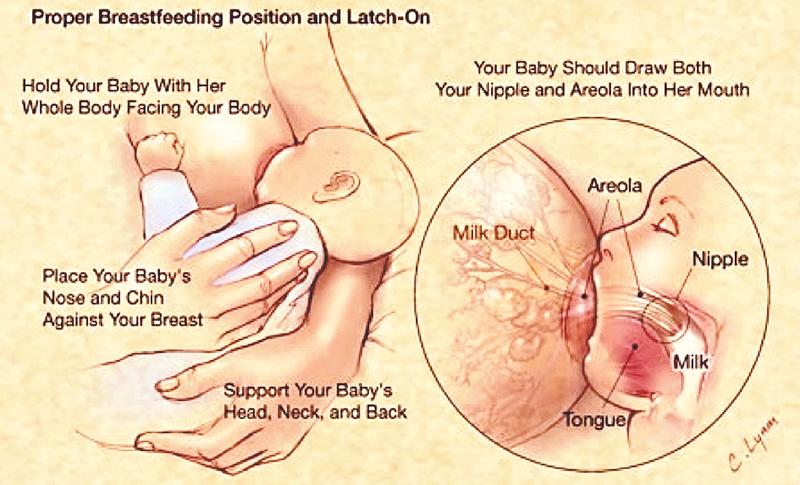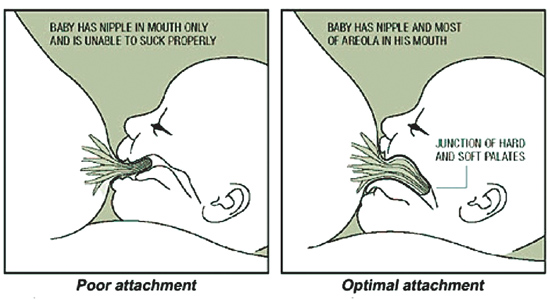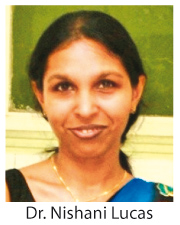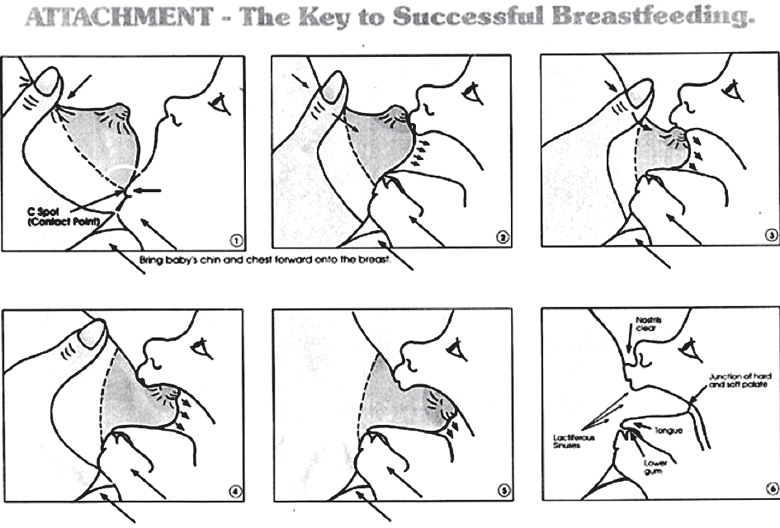
Continued from last week
Excerpts of the interview with Dr Nishani Lucas, Consultant Neonatologist, De Soysa Hospital for women.
Q. Exclusive breastfeeding has been recommended according to WHO guidelines for the first six months after which infants are put on complementary feeding. Do you agree?
A.Yes, I agree, as research has shown that breastfeeding alone provides the nutrients until completion of 6 months in the majority. Also, the incidence of diarrhoea is highest when introducing complementary feeds, therefore, unless medically indicated baby should be exclusively breastfed for 6 months. However, if the baby has growth failure according to the WHO growth chart on the Child Health Development Record or the mother has to return to work at the end of 4 months, complementary feeds should be started at the end of 4 months instead of introducing formula feeds in these situations.
Q.There are lots of myth surrounding breastfeeding. What are the most common?
A. Some believe that colostrum is harmful and should be discarded as it does not appear to be white like the mature milk which follows later. I have discussed the benefits of colostrum earlier.
 Also, most believe, if the mother is on medication, the milk has to be discarded. This is true only if the mother is receiving chemotherapy or radiotherapy as cancer treatment. Baby can be breastfed in all other situations.
Also, most believe, if the mother is on medication, the milk has to be discarded. This is true only if the mother is receiving chemotherapy or radiotherapy as cancer treatment. Baby can be breastfed in all other situations.
Mother can breastfeed irrespective of any maternal illness, only concerns remain with untreated open pulmonary tuberculosis and HIV. Antibodies from the mother protect the baby. Even with untreated smear positive pulmonary tuberculosis, we would express the breast milk to feed the baby via cup, while separating from the mother until she is smear negative following treatment. Baby of the HIV mother can be breastfed if the mother is on treatment and has very low viral loads as the transmission risk is very low. The decision to breastfeed with HIV should be taken on a case by case basis. Studies showed that formula feeding babies born to HIV mothers lead to more mortality due to the formula feeding rather than babies dying through HIV and recommendations were changed.
The size / shape of the breast or nipple has no bearing on breastfeeding. All women can breastfeed, provided the technique is learnt.
Q. There are also myths about what to eat and what not to eat while breastfeeding. ( heaty food and seethala kema) Your comments?
A. Mother is free to eat what she wishes. What should be avoided is smoking, alcohol, street drugs like heroin, cocaine etc. She should have a balanced nutritious diet. The milk she drinks has no bearing on her breast milk production. She should not double her food intake as this will lead to maternal obesity.
Q. If a mother has insufficient milk how can she increase her milk flow?
A. We have to first establish that she has insufficient milk. The only objective method of knowing whether milk is adequate is the weight gain of the baby. If baby is gaining weight 10-30g/day this means that mother is having enough milk. However, every baby loses up to 10% of his/her birth weight and is expected to regain it within the first 2-3 weeks of life.
If a baby has weight loss or poor weight gain, then the mother should get her breastfeeding technique evaluated and corrected. She can get this done by the Public Health Midwife or at the nearest Lactation Management Centre. These are situated at state hospitals that deliver maternity and newborn care. Mother should attend the Lactation Management Centre or the MOH clinic until she has established breastfeeding with good adequate gain.
Feeding the baby on demand, that is, when baby makes signs that he/she is hungry, not before 1 ½ hours since the last feed, will increase the milk production as suckling on the breast increases milk production via the hormone prolactin. Formula feeds should not be given as this will make the baby full and thereby stop baby from suckling the breast.
Baby should be positioned with his head and neck in line, as twisting the head on the body makes it difficult for the baby to drink. Baby’s head should be stabilized by holding at the nape of the neck, baby’s head should not be held with the hand as this will make baby pull away from the breast. Baby should be held as close as possible to the breast so that his chin presses in on the breast, as otherwise there will be no effective seal to enable the negative pressure exerted by the baby during suckling. Baby will not suffocate provided mother is not pressing on the baby’s head.
 When baby is positioned he/she should be latched on to the breast when opening the mouth wide “Arrrh” not “Oooh” as baby needs to latch onto the areola which is the big brown circle around the nipple. Almost all of the areola should be inside the baby’s mouth. More of the lower areola than the upper areola should be inside the baby’s mouth. When this occurs the nipple stretches inside the baby’s mouth and stimulates the suckling reflex by touching on the junction near the baby’s hard and soft palate. This makes the baby suckle and empty the breast. This sends signals to the brain that the breast has been emptied and needs to be refilled. This would maintain lactation.
When baby is positioned he/she should be latched on to the breast when opening the mouth wide “Arrrh” not “Oooh” as baby needs to latch onto the areola which is the big brown circle around the nipple. Almost all of the areola should be inside the baby’s mouth. More of the lower areola than the upper areola should be inside the baby’s mouth. When this occurs the nipple stretches inside the baby’s mouth and stimulates the suckling reflex by touching on the junction near the baby’s hard and soft palate. This makes the baby suckle and empty the breast. This sends signals to the brain that the breast has been emptied and needs to be refilled. This would maintain lactation.
If baby is latched on to the nipple instead of the areola, it will not stimulate the suckling reflex and thereby the baby will not get any milk although suckling, this is the commonest reason for poor weight gain and inadequate milk.
If the breast is not emptied, milk is not produced, so it starts a vicious cycle where milk flow will start decreasing.
Ensuring the correct technique of breastfeeding is mandatory to increase milk flow.
Q. What is your opinion about using powdered or fresh milk as substitutes when a mother returns to work ?
A. It is harmful to start animal milk at any age.
If the mother returns to work after the completion of 4 months, complementary feeds should be started at the end of 4 months, this includes 3 main meals and 2 snacks each around 3 hours apart. Breast milk can be given when mother returns home.
If she returns to work after 6 months, then complementary feeds have already been started.
In order to maintain the milk supply mother has to express the breast at least once during the working hours, if she works for 6 hours or more. The lunch interval can be utilized for this purpose. If there is a hygienic place where milk can be hygienically expressed into a clean cup which can be stored, milk can be taken home for the baby. Breast milk can be stored in room temperature for 6 hours, in the refrigerator for 24 hours and frozen for 2 weeks. If there is no hygienic place to collect the milk, mother can express and discard it in the washroom. It is important to empty the breast, as otherwise the milk supply will decrease, due to the feedback inhibitor.
Many, including me, have done this despite working 13 hour shifts, so it can be done!
Q.The bottle versus the breast. Your comments?.
A. Bottle is the enemy of the breast and should be avoided. The technique of sucking the bottle is very different to that of sucking the breast. This results in confusing the baby. It is called “suck confusion”. Baby has a higher chance of stopping feeding from the breast if the bottle is introduced. It also increases the risk of aspiration / choking.
If expressed, breast milk is medically prescribed it should be given through the cup, and never through the bottle. Also, the bottle is hard to clean and is a vector for deadly infection. So, if you love your baby always use the breast and not the bottle.
Q. At the De Soysa Hospital for women where you work I understand you have a special program for new mothers. Can you tell us more about it?
A. Mothers are taught about the benefits, technique and what to do when trouble shooting during the antenatal period. Breastfeeding is started within the first hour in all newborns with the support of the health staff. All mothers’ breastfeeding technique is checked and breastfeeding is supported until breastfeeding is established. Baby’s weight is checked daily to detect excessive weight loss and thereby poor establishment of breastfeeding.
These mothers are supported in the postnatal ward or where more support is required, one to one support is given in the special care baby unit. Baby is discharged only when reduced trend in weight loss / or good weight gain, with mother demonstrating the good feeding technique.
All babies are reviewed in the clinic within one week and until they achieve their birth weight, ensuring none of our babies are malnourished when they are discharged from our clinic. All our preterm babies including those who were 595g, twins and triplets are thriving on exclusive breastfeeding.
Q. Traditionally, it is the woman who has to give birth and then care for the baby while most males get away scot free. For new mothers to have to do everything by themselves with no help, breastfeeding for a longer period of time can be a problem. What are your views on paternity leave and on the role of men as carers of babies?
A. Both parents are responsible for the baby. I feel the father is pushed away by the ladies in the family. Father can cuddle, burp, change nappies and support mum. He can even give expressed breast milk via cup when needed. Given the opportunity, fathers are extremely supportive.
I know a father who helped raise a 700g 28 weeker, as his wife passed away! SO I would not underestimate the role of the father. I always talk to both parents, especially, when babies are sick or having problems and I have witnessed that in most instances fathers have been extremely supportive to the baby as well as the mother. Ask and you shall receive, we should involve the father more than the grandparents and you will see wonders!
Q. Some men object to their wives breastfeeding as it may spoil the shape of their body and they could develop large sagging breasts etc. Your comments?
A. I have not come across any fathers saying this, but there have been concerns raised by the mothers. Breast shape does not change, provided the breast is well supported, as this would not put a strain on the ligaments.
Well fitting brassieres should be worn during lactation, to ensure that the breast shape is retained. It should be the correct fit, if too tight it will obstruct milk flow and too loose it will not serve the purpose.
Q. What are the golden rules new mothers should follow to breastfeed their babies to the maximum time possible?
A. Baby comes first. Breastfeed – it is your responsibility as a mother. Do not give in to formula feeds, as that will poison your baby. Breastfeeding is a must and all women can do it unless both breasts have been surgically removed or are having pituitary dysfunction.
Breastfeeding is not easy - it is a skill that has to be learnt like driving– please get the support you need – you must do it for your baby’s sake. Do not give up. Every mother can do it ! Your baby is counting on you, don’t let him/her down! The size or shape of your breast or of your nipple does not matter !
Contact your midwife or the nearest Lactation Management Centre (in state hospitals providing maternity care) for feeding support. We, at De Soysa Hospital, Colombo 8 welcome you if in need of feeding advice.
Breastfeed within the first hour. Feed only when baby shows hunger cues at least 1 ½ hours after the last feed. DO NOT wake baby up for feeds. Do Not force feed. Always bring baby to the breast and not breast to the baby. Learn to console baby by touch and voice. Do not feed baby just because he is screaming, do not use the breast as a consoling strategy as it will inhibit baby’s self consoling skills.
Do not give in to bottles and formula, even if a doctor prescribes it please get a second opinion as unfortunately, even health care workers sometimes give wrong advice due to poor skills in lactation management. Easier doesn’t mean better, and money can’t buy health, so even the most expensive formula is poisonous to your baby.
Q. Your advice to grandparents?
A. Please support breastfeeding. Even if the baby is crying stay calm. Let the mother learn how to console the baby. Baby needs to get used to the mother. Do not break the confidence of the mother, by saying she has no milk.
Do not compare her to anyone. Offer help only if needed. DO NOT offer formula – you may have used it for your children, but now we know it is poisonous and is harmful, so please DO NOT poison your grandchild.
Let the mother handle the baby including calming the baby down, because, if the mother is not used to handling the baby, she is not going to be able to breastfeed successfully. Please help with the house work and cleaning until the baby has established breastfeeding. After mother is confident and breastfeeding is established you can definitely spend more time handling the baby.

